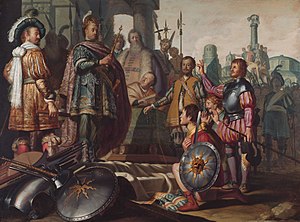
Rembrandt Harmenszoon van Rijn, usually simply known as Rembrandt, was a Dutch Golden Age painter, printmaker, and draughtsman. An innovative and prolific master in three media, he is generally considered one of the greatest visual artists in the history of art. It is estimated Rembrandt produced a total of about three hundred paintings, three hundred etchings, and two thousand drawings.
Ernst van de Wetering was a Dutch art historian and an expert on Rembrandt and his work.
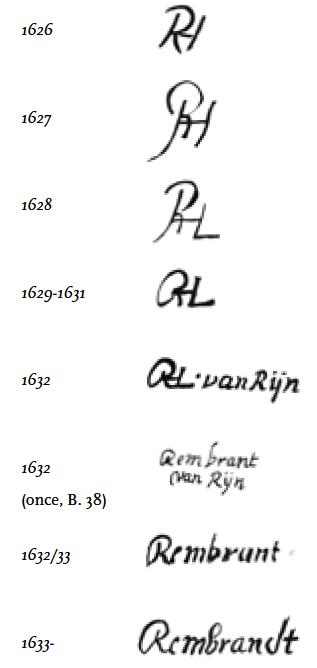
The Rembrandt Research Project (RRP) was an initiative of the Nederlandse Organisatie voor Wetenschappelijk Onderzoek (NWO), which is the Netherlands Organization for Scientific Research. Its purpose was to organize and categorize research on Rembrandt van Rijn, with the aim of discovering new facts about this Dutch Golden Age painter and his studio. The project started in 1968 and was sponsored by NWO until 1998. Research continued until 2014. It was the authority on Rembrandt and had the final say in whether a painting is genuine. The documentation generated by the project was transferred to the Netherlands Institute for Art History and renamed the Rembrandt Database.

Self Portrait is an oil-on-canvas painting by the Dutch artist Rembrandt. Painted in 1652, it is one of more than 40 painted self-portraits by Rembrandt, and was the first he had painted since 1645. In composition it is different from his previous self-portraits, depicting the painter in a direct frontal pose, hands on his hips, and with an air of self-confidence. It was painted the year that his financial difficulties began, and breaks with the sumptuous finery he had worn in previous self-portraits. Art historian Christopher White has called it "one of the most magisterial and sombre of these (late) pictures". It is in the Kunsthistorisches Museum in Vienna.

Self-Portrait with Two Circles is an oil-on-canvas painting by the Dutch artist Rembrandt, painted c. 1665–1669, one of over 40 painted self-portraits by Rembrandt.

Self-Portrait with Beret and Turned-Up Collar is a 1659 oil on canvas painting by the Dutch artist Rembrandt, one of over 40 self-portraits by Rembrandt. It has been noted as a self-portrayal of subtle and somber qualities, a work in which may be seen "the stresses and strains of a life compounded of creative triumphs and personal and financial reverses". Once owned by Andrew W. Mellon, it has been in the National Gallery of Art since 1937.

The dozens of self-portraits by Rembrandt were an important part of his oeuvre. Rembrandt created approaching one hundred self-portraits including over forty paintings, thirty-one etchings and about seven drawings; some remain uncertain as to the identity of either the subject or the artist, or the definition of a portrait.

Horst Gerson was a German-Dutch art historian.
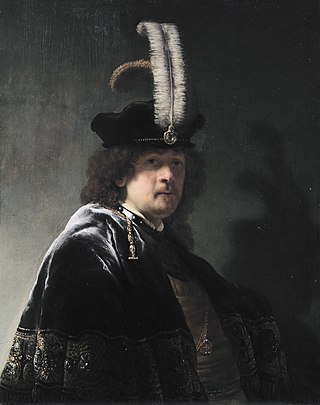
Self-portrait wearing a white feathered bonnet is an oil painting attributed to the Dutch painter Rembrandt. It is signed and dated 1635. It was traditionally regarded as a Rembrandt self-portrait until 1968, when it was rejected on stylistic grounds in the Rembrandt catalogue raisonné by Horst Gerson. In 2013, art historian Ernst van de Wetering re-attributed the painting as an original Rembrandt. It is one of over 40 painted self-portraits by Rembrandt.

Descent from the Cross (1634), by Rembrandt Harmenszoon van Rijn, is one of his many religious scenes. The piece is oil on canvas and now located in the Hermitage Museum in St. Petersburg. The piece is intriguing stylistically in its unique figural composition and variety of lighting effects. Aside from composition, the painting is notable in terms of its historical context, from the connection between its subject matter and Rembrandt's family situation to its endangered location during World War II.

Slaughtered Ox, also known as Flayed Ox, Side of Beef, or Carcass of Beef, is a 1655 oil on beech panel still life painting by Rembrandt. It has been in the collection of the Louvre in Paris since 1857. A similar painting is in Kelvingrove Art Gallery and Museum, Glasgow, possibly not created by Rembrandt himself but probably by one of his pupils, perhaps Carel Fabritius. Other similar paintings by Rembrandt or more likely his circle are held by museums in Budapest and Philadelphia.

The Portrait of Dirck van Os is a later painting by Rembrandt (1606-1669), created circa 1658. It is currently in the permanent collection of the Joslyn Art Museum in Omaha, Nebraska.
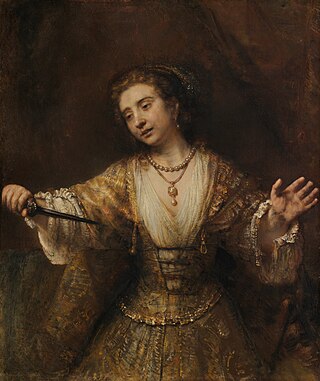
Lucretia is a 1664 history painting historically attributed to the Dutch Golden Age painter Rembrandt in the collection of the National Gallery of Art. In 2015, Ernst van de Wetering of the Rembrandt Research Project said that "the formal properties and execution of [this] painting, I am convinced, exclude the possibility that it could be an autograph work by Rembrandt", and that the painting recalls Aert de Gelder. The painting is not included in the project's 2015 Rembrandt corpus.

The Girl in a Picture Frame is a 1641 oil on panel painting by the Dutch artist Rembrandt. It is also known as The Jewish Bride and The Girl in a Hat. With The Scholar at the Lectern and Landscape with the Good Samaritan, it is one of three Rembrandt paintings in Polish collections. It is currently located at the Royal Castle in Warsaw.
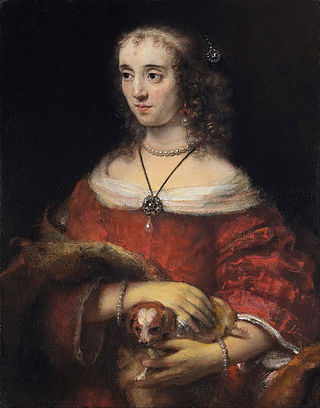
Young Woman with a Lapdog is a c. 1665 oil-on-canvas painting of an unknown young woman by Rembrandt. It is now in the Art Gallery of Ontario, to which it was bequeathed in 1955 by the philanthropist Frank Peter Wood. It was previously identified as Rembrandt's daughter-in-law Magdalena van Loo (1641–1669), but the subject is now held to be unknown.

Abraham Serving the Three Angels is a 1646 oil-on-panel painting by Rembrandt. The scene depicts Abraham, it is based on an episode from the Book of Genesis and it has Mughal influence. Today it is in a private collection since it was bought in an auction in 1848 for £64. Before that its owners were Ferdinand Bol, a student of Rembrandt, the Dutch art collector and Mayor of Amsterdam, Jan Six as well as Benjamin West, an American artist.

The Preacher Eleazar Swalmius is a 1637 oil-on-canvas painting by the Dutch artist Rembrandt. It is currently owned by the Royal Museum of Fine Arts in Antwerp. The painting has been certified a real Rembrandt. The painting was listed in 1727 in the catalog of the Duke of Orléans collection, as a portrait of an Amsterdam mayor by Rembrandt. It remained in the noble family's possession until 1792, when Duke Louis-Philippe-Joseph sold the entire collection to finance his political career and pay off debts. The painting passed through several English collections into the hands of the Bourgeois brothers, art dealers from Cologne, who sold the painting as an original Rembrandt to the museum in 1886. The painting was stored away for a long time due to doubts cast over its authenticity.
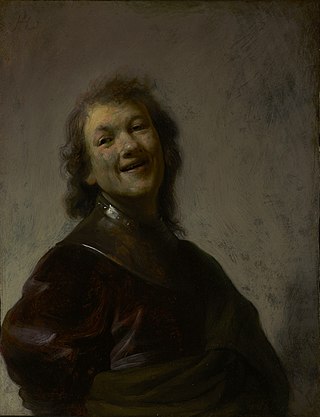
Rembrandt Laughing is a c. 1628 oil on copper painting by the Dutch painter Rembrandt van Rijn. It is an elaborate study of a laughing face, a tronie, and, since it represents the painter himself, one of over 40 self-portraits by Rembrandt, probably the earliest elaborate one. The painting, which was only recently discovered, is now in the J. Paul Getty Museum, California.
